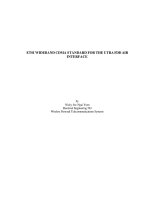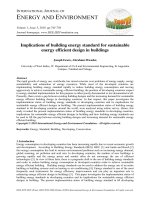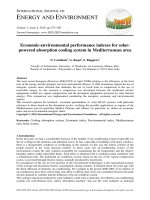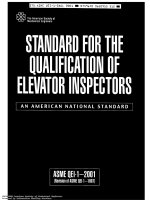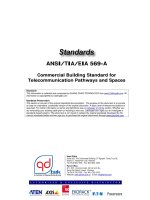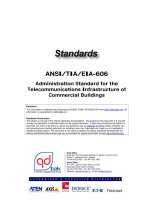CLSI 2013: performance standard for antimicrobial susceptibility testing 2013
Bạn đang xem bản rút gọn của tài liệu. Xem và tải ngay bản đầy đủ của tài liệu tại đây (4.03 MB, 205 trang )
January 2013
M100-S23
Performance Standards for Antimicrobial
Susceptibility Testing; Twenty-Third
Informational Supplement
This document provides updated tables for the Clinical and Laboratory
Standards Institute antimicrobial susceptibility testing standards
M02-A11, M07-A9, and M11-A8.
An informational supplement for global application developed through the Clinical and Laboratory Standards Institute
consensus process.
Licensed to: BD BD
This document is protected by copyright. CLSI order # 21034, Downloaded on 1/6/2013.
Clinical and Laboratory Standards Institute
Setting the standard for quality in clinical laboratory testing around the world.
The Clinical and Laboratory Standards Institute (CLSI) is a not-for-profit membership organization that brings together
the varied perspectives and expertise of the worldwide laboratory community for the advancement of a common cause:
to foster excellence in laboratory medicine by developing and implementing clinical laboratory standards and guidelines
that help laboratories fulfill their responsibilities with efficiency, effectiveness, and global applicability.
Consensus Process
Consensus—the substantial agreement by materially affected, competent, and interested parties—is core to the
development of all CLSI documents. It does not always connote unanimous agreement, but does mean that the
participants in the development of a consensus document have considered and resolved all relevant objections and
accept the resulting agreement.
Commenting on Documents
CLSI documents undergo periodic evaluation and modification to keep pace with advancements in technologies,
procedures, methods, and protocols affecting the laboratory or health care.
CLSI’s consensus process depends on experts who volunteer to serve as contributing authors and/or as participants in
the reviewing and commenting process. At the end of each comment period, the committee that developed the
document is obligated to review all comments, respond in writing to all substantive comments, and revise the draft
document as appropriate.
Comments on published CLSI documents are equally essential, and may be submitted by anyone, at any time, on any
document. All comments are addressed according to the consensus process by a committee of experts.
Appeals Process
If it is believed that an objection has not been adequately addressed, the process for appeals is documented in the CLSI
Administrative Procedures.
All comments and responses submitted on draft and published documents are retained on file at CLSI and are available
upon request.
Get Involved—Volunteer!
Do you use CLSI documents in your workplace? Do you see room for improvement? Would you like to get involved in the
revision process? Or maybe you see a need to develop a new document for an emerging technology? CLSI wants to hear
from you. We are always looking for volunteers. By donating your time and talents to improve the standards that affect
your own work, you will play an active role in improving public health across the globe.
For further information on committee participation or to submit comments, contact CLSI.
Clinical and Laboratory Standards Institute
950 West Valley Road, Suite 2500
Wayne, PA 19087 USA
P: 610.688.0100
F: 610.688.0700
www.clsi.org
Licensed to: BD BD
This document is protected by copyright. CLSI order # 21034, Downloaded on 1/6/2013.
Vol. 33 No. 1 M100-S23
1
Performance Standards for Antimicrobial Susceptibility Testing;
Twenty-Third Informational Supplement
Abstract
The supplemental information presented in this document is intended for use with the antimicrobial
susceptibility testing procedures published in the following Clinical and Laboratory Standards Institute
(CLSI)–approved standards: M02-A11—Performance Standards for Antimicrobial Disk Susceptibility
Tests; Approved Standard—Eleventh Edition; M07-A9—Methods for Dilution Antimicrobial
Susceptibility Tests for Bacteria That Grow Aerobically; Approved Standard—Ninth Edition; and M11-
A8—Methods for Antimicrobial Susceptibility Testing of Anaerobic Bacteria; Approved Standard—
Eighth Edition. The standards contain information about both disk (M02) and dilution (M07 and M11)
test procedures for aerobic and anaerobic bacteria.
Clinicians depend heavily on information from the clinical microbiology laboratory for treatment of their
seriously ill patients. The clinical importance of antimicrobial susceptibility test results requires that these
tests be performed under optimal conditions and that laboratories have the capability to provide results for
the newest antimicrobial agents.
The tabular information presented here represents the most current information for drug selection,
interpretation, and quality control using the procedures standardized in the most current editions of M02,
M07, and M11. Users should replace the tables published earlier with these new tables. (Changes in the
tables since the most current edition appear in boldface type.)
Clinical and Laboratory Standards Institute. Performance Standards for Antimicrobial Susceptibility
Testing; Twenty-Third Informational Supplement. CLSI document M100-S23 (ISBN 1-56238-865-7
[Print]; ISBN 1-56238-866-5 [Electronic]). Clinical and Laboratory Standards Institute, 950 West Valley
Road, Suite 2500, Wayne, Pennsylvania 19087 USA, 2013.
The data in the interpretive tables in this supplement are valid only if the
methodologies in M02-A11—Performance Standards for Antimicrobial Disk
Susceptibility Tests; Approved Standard—Eleventh Edition; M07-A9—Methods
for Dilution Antimicrobial Susceptibility Tests for Bacteria That Grow
Aerobically; Approved Standard—Ninth Edition; and M11-A8—Methods for
Antimicrobial Susceptibility Testing of Anaerobic Bacteria; Approved Standard—
Eighth Edition are followed.
Licensed to: BD BD
This document is protected by copyright. CLSI order # 21034, Downloaded on 1/6/2013.
January 2013 M100-S23
2
Licensed to: BD BD
This document is protected by copyright. CLSI order # 21034, Downloaded on 1/6/2013.
ISBN 1-56238-865-7 (Print) M100-S23
ISBN 1-56238-866-5 (Electronic) Vol. 33 No. 1
ISSN 1558-6502 (Print) Replaces M100-S22
ISSN 2162-2914 (Electronic) Vol. 32 No. 3
Performance Standards for Antimicrobial Susceptibility Testing;
Twenty-Third Informational Supplement
Volume 33 Number 1
Franklin R. Cockerill, III, MD
Jean B. Patel, PhD, D(ABMM)
Jeff Alder, PhD
Patricia A. Bradford, PhD
Michael N. Dudley, PharmD, FIDSA
George M. Eliopoulos, MD
Dwight J. Hardy, PhD
David W. Hecht, MD, MS, MBA
Janet A. Hindler, MCLS, MT(ASCP)
Mair Powell, MD, FRCP, FRCPath
Jana M. Swenson, MMSc
Richard B. Thomson Jr., PhD
Maria M. Traczewski, BS, MT(ASCP)
John D. Turnidge, MD
Melvin P. Weinstein, MD
Barbara L. Zimmer, PhD
Licensed to: BD BD
This document is protected by copyright. CLSI order # 21034, Downloaded on 1/6/2013.
January 2013 M100-S23
4
Copyright
©
2013 Clinical and Laboratory Standards Institute. Except as stated below, any reproduction of
content from a CLSI copyrighted standard, guideline, companion product, or other material requires
express written consent from CLSI. All rights reserved. Interested parties may send permission requests to
CLSI hereby grants permission to each individual member or purchaser to make a single reproduction of
this publication for use in its laboratory procedure manual at a single site. To request permission to use
this publication in any other manner, e-mail
Suggested Citation
CLSI. Performance Standards for Antimicrobial Susceptibility Testing; Twenty-Third Informational
Supplement. CLSI document M100-S23. Wayne, PA: Clinical and Laboratory Standards Institute; 2013.
Twenty-Third Informational Supplement
January 2013
Sixteenth Informational Supplement
January 2006
Twenty-Second Informational Supplement
January 2012
Fifteenth Informational Supplement
January 2005
Twenty-First Informational Supplement
January 2011
Fourteenth Informational Supplement
January 2004
Twentieth Informational Supplement (Update)
June 2010
Thirteenth Informational Supplement
January 2003
Twentieth Informational Supplement
January 2010
Twelfth Informational Supplement
January 2002
Nineteenth Informational Supplement
January 2009
Eleventh Informational Supplement
January 2001
Eighteenth Informational Supplement
January 2008
Tenth Informational Supplement
January 2000
Seventeenth Informational Supplement
January 2007
Ninth Informational Supplement
January 1999
ISBN 1-56238-865-7 (Print)
ISBN 1-56238-866-5 (Electronic)
ISSN 1558-6502 (Print)
ISSN 2162-2914 (Electronic)
Licensed to: BD BD
This document is protected by copyright. CLSI order # 21034, Downloaded on 1/6/2013.
Vol. 33 No. 1 M100-S23
5
Committee Membership
Consensus Committee on Microbiology
Subcommittee on Antimicrobial Susceptibility Testing
Franklin R. Cockerill, III, MD
Chairholder
Mayo College of Medicine
Rochester, Minnesota, USA
Jean B. Patel, PhD, D(ABMM)
Vice-Chairholder
Centers for Disease Control and
Prevention
Atlanta, Georgia, USA
Jeff Alder, PhD
Bayer HealthCare
Pinebrook, New Jersey, USA
Patricia A. Bradford, PhD
AstraZeneca Pharmaceuticals
Waltham, Massachusetts, USA
Michael N. Dudley, PharmD, FIDSA
Rempex Pharmaceuticals, Inc.
San Diego, California, USA
George M. Eliopoulos, MD
Beth Israel Deaconess Medical Center
Boston, Massachusetts, USA
Dwight J. Hardy, PhD
University of Rochester Medical Center
Rochester, New York, USA
David W. Hecht, MD, MS, MBA
Loyola University Medical Center
Maywood, Illinois, USA
Janet A. Hindler, MCLS, MT(ASCP)
UCLA Medical Center
Los Angeles, California, USA
Mair Powell, MD, FRCP, FRCPath
MHRA
London, United Kingdom
Richard B. Thomson, Jr., PhD
Evanston Hospital, NorthShore
University HealthSystem
Evanston, Illinois, USA
John D. Turnidge, MD
SA Pathology at Women’s and
Children’s Hospital
North Adelaide, Australia
Melvin P. Weinstein, MD
Robert Wood Johnson Medical School
New Brunswick, New Jersey, USA
Barbara L. Zimmer, PhD
Siemens Healthcare Diagnostics Inc.
West Sacramento, California, USA
Acknowledgment
CLSI and the Consensus Committee on Microbiology gratefully acknowledge the following individuals
for their help in preparing this document:
Jana M. Swenson, MMSc
Consultant
Chattahoochee Hills, Georgia,
USA
Maria M. Traczewski, BS,
MT(ASCP)
The Clinical Microbiology
Institute
Wilsonville, Oregon, USA
John H. Rex, MD, FACP
Chairholder
AstraZeneca Pharmaceuticals
Waltham, Massachusetts, USA
Richard B. Thomson, Jr., PhD
Vice-Chairholder
Evanston Hospital, NorthShore
University HealthSystem
Evanston, Illinois, USA
Nancy L. Anderson, MMSc,
MT(ASCP)
Centers for Disease Control and
Prevention
Atlanta, Georgia, USA
Barbara Ann Body, PhD, D(ABMM)
Laboratory Corporation of America
Burlington, North Carolina, USA
Betty (Betz) A. Forbes, PhD,
D(ABMM)
Medical College of Virginia Campus
Richmond, Virginia, USA
Thomas R. Fritsche, MD, PhD
Marshfield Clinic
Marshfield, Wisconsin, USA
Frederic J. Marsik, PhD, ABMM
FDA Center for Drug Evaluation and
Research
Silver Spring, Maryland, USA
Patrick R. Murray, PhD
BD Diagnostics
Sparks, Maryland, USA
Fred C. Tenover, PhD, D(ABMM)
Cepheid
Sunnyvale, California, USA
John D. Turnidge, MD
SA Pathology at Women’s and
Children’s Hospital
North Adelaide, Australia
Licensed to: BD BD
This document is protected by copyright. CLSI order # 21034, Downloaded on 1/6/2013.
January 2013 M100-S23
6
Text and Table Working Group
Jana M. Swenson, MMSc
Chairholder
Consultant
Chattahoochee Hills, Georgia, USA
Maria M. Traczewski, BS, MT(ASCP)
Committee Secretary
The Clinical Microbiology Institute
Wilsonville, Oregon, USA
Janet A. Hindler, MCLS, MT(ASCP)
UCLA Medical Center
Los Angeles, California, USA
Judith Johnston, MS
Siemens Healthcare Diagnostics Inc.
West Sacramento, California, USA
Dyan Luper, BS, MT(ASCP)SM
BD Diagnostic Systems
Sparks, Maryland, USA
Linda M. Mann, PhD, D(ABMM)
Siemens Healthcare Diagnostics Inc.
West Sacramento, California, USA
Frederic J. Marsik, PhD, ABMM
FDA Center for Drug Evaluation and
Research
Silver Spring, Maryland, USA
Susan D. Munro, MT(ASCP)
Campbell, California, USA
Flavia Rossi, MD
University of Sao Paulo
Sao Paulo, Brazil
Jeff Schapiro
Kaiser Permanente
Alamo, California, USA
Dale A. Schwab, PhD, D(ABMM)
Quest Diagnostics, Nichols Institute
San Juan Capistrano, California, USA
Richard B. Thomson, Jr., PhD
Evanston Hospital, NorthShore
University HealthSystem
Evanston, Illinois, USA
Mary K. York, PhD, ABMM
MKY Microbiology Consulting
Walnut Creek, California, USA
Quality Control Working Group
Steven D. Brown, PhD, ABMM
Co-Chairholder
The Clinical Microbiology Institute
Wilsonville, Oregon, USA
Sharon K. Cullen, BS, RAC
Co-Chairholder
Siemens Healthcare Diagnostics
West Sacramento, California, USA
William B. Brasso
BD Diagnostic Systems
Sparks, Maryland, USA
Stephen Hawser, PhD
IHMA Europe Sàrl
Epalinges, Switzerland, USA
Janet A. Hindler, MCLS, MT(ASCP)
UCLA Medical Center
Los Angeles, California, USA
Michael D. Huband
AstraZeneca Pharmaceuticals
Waltham, Massachusetts, USA
Ronald N. Jones, MD
JMI Laboratories
North Liberty, Iowa, USA
Ann Macone
Paratek Pharmaceuticals, Inc.
Boston, Massachusetts, USA
Ross Mulder, MT(ASCP)
bioMérieux, Inc.
Hazelwood, Missouri, USA
Susan D. Munro, MT(ASCP)
Campbell, California, USA
Jean B. Patel, PhD, D(ABMM)
Centers for Disease Control and
Prevention
Atlanta, Georgia, USA
Robert P. Rennie, PhD
University of Alberta Hospital
Edmonton, Alberta, Canada
Frank O. Wegerhoff, PhD
Covance Central Laboratory Services,
Inc.
Indianapolis, Indiana, USA
Licensed to: BD BD
This document is protected by copyright. CLSI order # 21034, Downloaded on 1/6/2013.
Vol. 33 No. 1 M100-S23
7
Staphylococcal and Streptococcal Working Group
Brandi Limbago, PhD
Chairholder
Centers for Disease Control and
Prevention
Atlanta, Georgia, USA
Sandra S. Richter, MD, D(ABMM)
Committee Secretary
Cleveland Clinic
Cleveland, Ohio, USA
Patricia A. Bradford, PhD
AstraZeneca Pharmaceuticals
Waltham, Massachusetts, USA
William A. Craig, MD
University of Wisconsin School of
Medicine
Madison, Wisconsin, USA
Michael N. Dudley, PharmD, FIDSA
Rempex Pharmaceuticals, Inc.
San Diego, California, USA
George M. Eliopoulos, MD
Beth Israel Deaconess Medical Center
Boston, Massachusetts, USA
Daniel F. Sahm, PhD
Eurofins Medinet
Chantilly, Virginia, USA
Susan Sharp, PhD, D(ABMM)
Kaiser Permanente-NW
Portland, Oregon, USA
Robert Skov, MD
Statens Serum Institut
Copenhagen, Denmark
Jana M. Swenson, MMSc
Consultant
Chattahoochee Hills, Georgia, USA
Richard B. Thomson, Jr., PhD
Evanston Hospital, NorthShore
University HealthSystem
Evanston, Illinois, USA
Maria M. Traczewski, BS,
MT(ASCP)
The Clinical Microbiology Institute
Wilsonville, Oregon, USA
Melvin P. Weinstein, MD
Robert Wood Johnson Medical
School
New Brunswick, New Jersey, USA
Enterobacteriaceae Working Group
Stephen G. Jenkins, PhD, D(ABMM),
F(AAM)
Chairholder
NewYork-Presbyterian Hospital
New York, New York, USA
Patricia A. Bradford, PhD
Committee Secretary
AstraZeneca Pharmaceuticals
Waltham, Massachusetts, USA
Dwight J. Hardy, PhD
Committee Secretary
University of Rochester Medical Center
Rochester, New York, USA
Paul G. Ambrose, PharmD, FIDSA
ICPD/Ordway Research
Latham, New York, USA
William A. Craig, MD
University of Wisconsin School of
Medicine
Madison, Wisconsin, USA
Michael N. Dudley, PharmD, FIDSA
Rempex Pharmaceuticals, Inc.
San Diego, California, USA
Ronald N. Jones, MD
JMI Laboratories
North Liberty, Iowa, USA
James S. Lewis, II, PharmD
University of Texas Health Science
Center
San Antonio, Texas, USA
Paul C. Schreckenberger, PhD,
D(ABMM), F(AAM)
Loyola University Medical Center
Maywood, Illinois, USA
Audrey N. Schuetz, MD, MPH,
D(ABMM)
Weill Cornell Medical College/
NewYork-Presbyterian Hospital
New York, New York, USA
Lauri D. Thrupp, MD
University of California Irvine
Medical Center
Orange, California, USA
John D. Turnidge, MD
SA Pathology at Women’s and
Children’s Hospital
North Adelaide, Australia
Melvin P. Weinstein, MD
Robert Wood Johnson Medical
School
New Brunswick, New Jersey, USA
Barbara L. Zimmer, PhD
Siemens Healthcare Diagnostics Inc.
West Sacramento, California, USA
Licensed to: BD BD
This document is protected by copyright. CLSI order # 21034, Downloaded on 1/6/2013.
January 2013 M100-S23
8
Fluoroquinolone Breakpoint Working Group
Cynthia L. Fowler, MD
MFHSC
Chairholder
Santa Fe, New Mexico, USA
Karen Bush, PhD
Committee Secretary
Indiana University
Bloomington, Indiana, USA
Jeff Alder, PhD
Bayer HealthCare
Pinebrook, New Jersey, USA
Sujata M. Bhavnani, PharmD
Ordway Research Institute
Latham, New York, USA
George M. Eliopoulos, MD
Beth Israel Deaconess Medical Center
Boston, Massachusetts, USA
Robert K. Flamm, PhD
JMI Laboratories
North Liberty, Iowa, USA
Marcelo Galas
Reference Centres of Latinoamerican
Countries
Argentina
Elizabeth Palavecino, MD
Wake Forest University Baptist
Medical Center
Winston-Salem, North Carolina,
USA
Mair Powell, MD, FRCP, FRCPath
MHRA
London, United Kingdom
L. Barth Reller, MD
Duke University Medical Center
Durham, North Carolina, USA
Helio S. Sader, MD, PhD
JMI Laboratories
North Liberty, Iowa, USA
Lauri D. Thrupp, MD
University of California Irvine
Medical Center
Orange, California, USA
Melvin P. Weinstein, MD
Robert Wood Johnson Medical
School
New Brunswick, New Jersey, USA
Intrinsic Resistance Working Group
Barbara L. Zimmer, PhD
Chairholder
Siemens Healthcare Diagnostics Inc.
West Sacramento, California, USA
Dyan Luper, BS, MT(ASCP)SM
Committee Secretary
BD Diagnostic Systems
Sparks, Maryland, USA
Jeff Alder, PhD
Bayer HealthCare
Pinebrook, New Jersey, USA
Eliana S. Armstrong, PhD
Achaogen, Inc
San Francisco, California, USA
Rafael Cantón, PhD
Hospital Universitario Ramón y Cajal
Madrid, Spain
German Esparza, BSc
Proasecal S.A.S
Bogota, Colombia
Kate Murfitt
Mount Auburn Hospital
Cambridge, Massachusetts, USA
Sandra S. Richter, MD, D(ABMM)
Cleveland Clinic
Cleveland, Ohio, USA
Paul C. Schreckenberger, PhD,
D(ABMM), F(AAM)
Loyola University Medical Center
Maywood, Illinois, USA
Susan Sharp, PhD, D(ABMM)
Kaiser Permanente-NW
Portland, Oregon, USA
Carole Shubert
bioMérieux, Inc.
Hazelwood, Missouri, USA
Richard B. Thomson, Jr., PhD
Evanston Hospital, NorthShore
University HealthSystem
Evanston, Illinois, USA
Licensed to: BD BD
This document is protected by copyright. CLSI order # 21034, Downloaded on 1/6/2013.
Vol. 33 No. 1 M100-S23
9
Anaerobic Bacteria Working Group
David W. Hecht, MD, MS,
MBA
Loyola University Medical
Center
Maywood, Illinois, USA
Diane M. Citron, M(ASCP)
R.M. Alden Research
Laboratory
Culver City, California, USA
Joanne Dzink-Fox, PhD
Novartis Institutes for
Biomedical Research
Cambridge, Massachusetts,
USA
William W. Gregory, PhD
Pfizer Inc
New York, New York, USA
Nilda V. Jacobus
Tufts Medical Center
Auburn, Maine, USA
Stephen G. Jenkins, PhD,
D(ABMM), F(AAM)
NewYork-Presbyterian
Hospital
New York, New York, USA
Audrey N. Schuetz, MD, MPH,
D(ABMM)
Weill Cornell Medical College/
NewYork-Presbyterian
Hospital
New York, New York, USA
Hannah Wexler, PhD
Greater Los Angeles VA
Healthcare System
UCLA School of Medicine
Los Angeles, California, USA
Staff
Clinical and Laboratory Standards Institute
Wayne, Pennsylvania, USA
Luann Ochs, MS
Senior Vice President – Operations
Tracy A. Dooley, MLT(ASCP)
Staff Liaison
Megan L. Tertel, MA
Editor
Ryan J. Torres
Assistant Editor
Licensed to: BD BD
This document is protected by copyright. CLSI order # 21034, Downloaded on 1/6/2013.
January 2013 M100-S23
10
Licensed to: BD BD
This document is protected by copyright. CLSI order # 21034, Downloaded on 1/6/2013.
Vol. 33 No. 1 M100-S23
11
Contents
Abstract 1
Committee Membership 5
Summary of Major Changes in This Document 15
Summary of CLSI Processes for Establishing Interpretive Criteria and Quality Control Ranges 21
CLSI Reference Methods vs Commercial Methods and CLSI vs FDA Interpretive Criteria
(Breakpoints) 22
Subcommittee on Antimicrobial Susceptibility Testing Mission Statement 24
Instructions for Use of Tables 25
Table 1A. Suggested Groupings of Antimicrobial Agents With FDA Clinical Indications That Should
Be Considered for Routine Testing and Reporting on Nonfastidious Organisms by Clinical
Microbiology Laboratories in the United States 34
Table 1B. Suggested Groupings of Antimicrobial Agents With FDA Clinical Indications That Should
Be Considered for Routine Testing and Reporting on Fastidious Organisms by Clinical Microbiology
Laboratories in the United States 38
Table 1C. Suggested Groupings of Antimicrobial Agents That Should Be Considered for Routine
Testing and Reporting on Anaerobic Organisms 42
Tables 2A–2J. Zone Diameter and Minimal Inhibitory Concentration (MIC) Interpretive Standards
for:
2A. Enterobacteriaceae 44
Table 2A Supplemental Table 1. Screening and Confirmatory Tests for ESBLs in Klebsiella
pneumoniae, Klebsiella oxytoca, Escherichia coli, and Proteus mirabilis for Use With Table 2A 50
Table 2A Supplemental Table 2. Confirmatory Test for Suspected Carbapenemase Production in
Enterobacteriaceae for Use With Table 2A………………………… 53
Table 2A Supplemental Table 3. Screening and Confirmatory Tests for Suspected Carbapenemase
Production in Enterobacteriaceae When Using “Old” Interpretive Criteria for Carbapenems (for Use
With Table 2A in M100-S20 [January 2010]) 57
2B-1. Pseudomonas aeruginosa 62
2B-2. Acinetobacter spp. 66
2B-3. Burkholderia cepacia 68
2B-4. Stenotrophomonas maltophilia 69
2B-5. Other Non-Enterobacteriaceae 70
2C. Staphylococcus spp. 72
Table of Contents
Licensed to: BD BD
This document is protected by copyright. CLSI order # 21034, Downloaded on 1/6/2013.
January 2013 M100-S23
12
Contents (Continued)
Table 2C Supplemental Table 1. Screening Tests for -Lactamase Production, Oxacillin Resistance,
and mecA-Mediated Oxacillin Resistance Using Cefoxitin in the Staphylococcus aureus Group for
Use With Table 2C………… 80
Table 2C Supplemental Table 2. Screening Tests for Vancomycin MIC
8 g/mL, Inducible
Clindamycin Resistance, and High-Level Mupirocin Resistance in the Staphylococcus aureus Group
for Use With Table 2C………… 84
Table 2C Supplemental Table 3. Screening Tests for -Lactamase Production, mecA-Mediated Oxacillin
Resistance Using Cefoxitin, and Inducible Clindamycin Resistance in Coagulase-Negative
Staphylococci (except Staphylococcus lugdunensis) for Use With Table 2C……………………… 87
2D. Enterococcus spp. 90
Table 2D Supplemental Table 1. Screening Tests for High-Level Aminoglycoside Resistance (HLAR)
and Vancomycin MIC ≥
8 g/mL in Enterococcus spp. for Use With Table 2D 94
2E. Haemophilus influenzae and Haemophilus parainfluenzae 96
2F. Neisseria gonorrhoeae 100
2G. Streptococcus pneumoniae 104
Table 2G Supplemental Table 1. Screening Test for Inducible Clindamycin Resistance in Streptococcus
pneumoniae for Use With Table 2G 109
2H-1. Streptococcus spp. -Hemolytic Group 112
Table 2H-1 Supplemental Table 1. Screening Test for Inducible Clindamycin Resistance in
Streptococcus spp., -Hemolytic Group for Use With Table 2H-1 116
2H-2. Streptococcus spp. Viridans Group 118
2I. Neisseria meningitidis 122
2J. Anaerobes 126
Table 3A. Disk Diffusion: Quality Control Ranges for Nonfastidious Organisms (Unsupplemented
Mueller-Hinton Medium) 130
Table 3B. Disk Diffusion: Quality Control Ranges for Fastidious Organisms 134
Table 3C. Disk Diffusion: Reference Guide to Quality Control Frequency 136
Table 3D. Disk Diffusion: Troubleshooting Guide 140
Table 4A. MIC: Quality Control Ranges for Nonfastidious Organisms (Unsupplemented Mueller-
Hinton Medium [Cation-Adjusted if Broth]) 142
Table 4B. MIC: Quality Control Ranges for Fastidious Organisms (Broth Dilution Methods) 146
Table of Contents
Licensed to: BD BD
This document is protected by copyright. CLSI order # 21034, Downloaded on 1/6/2013.
Vol. 33 No. 1 M100-S23
13
Contents (Continued)
Table 4C. MIC: Quality Control Ranges for Neisseria gonorrhoeae (Agar Dilution Method) 148
Table 4D. MIC: Quality Control Ranges for Anaerobes (Agar Dilution Method) 149
Table 4E. MIC: Quality Control Ranges for Anaerobes (Broth Microdilution Method) 150
Table 4F. MIC: Reference Guide to Quality Control Frequency 152
Table 4G. MIC: Troubleshooting Guide 156
Table 5A. Solvents and Diluents for Preparation of Stock Solutions of Antimicrobial Agents 160
Table 5B. Preparation of Stock Solutions for Antimicrobial Agents Provided With Activity
Expressed as Units. 164
Table 5C. Preparation of Solutions and Media Containing Combinations of Antimicrobial Agents 166
Table 6A. Scheme for Preparing Dilutions of Antimicrobial Agents to Be Used in Agar Dilution
Susceptibility Tests 168
Table 7A. Scheme for Preparing Dilutions of Antimicrobial Agents to Be Used in Broth Dilution
Susceptibility Tests 170
Table 7B. Scheme for Preparing Dilutions of Water-Insoluble Antimicrobial Agents to Be Used in
Broth Dilution Susceptibility Tests 171
Appendix A. Suggestions for Confirmation of Resistant (R), Intermediate (I), or Nonsusceptible
(NS) Antimicrobial Susceptibility Test Results and Organism Identification 172
Appendix B. Intrinsic Resistance 176
Appendix C. Quality Control Strains for Antimicrobial Susceptibility Tests 182
Appendix D. Cumulative Antimicrobial Susceptibility Report for Bacteroides fragilis Group
Organisms 186
Appendix E. Cumulative Antimicrobial Susceptibility Report for Anaerobic Organisms Other Than
Bacteroides fragilis Group 187
Glossary I (Part 1). -Lactams: Class and Subclass Designation and Generic Name 190
Glossary I (Part 2). Non–-Lactams: Class and Subclass Designation and Generic Name 191
Glossary II. Abbreviations/Routes of Administration/Drug Class for Antimicrobial Agents Listed in
M100-S23 192
Glossary III. List of Identical Abbreviations Used for More Than One Antimicrobial Agent in US
Diagnostic Products 195
Informational – User Questions and Subcommittee Responses 196
Table of Contents
Licensed to: BD BD
This document is protected by copyright. CLSI order # 21034, Downloaded on 1/6/2013.
January 2013 M100-S23
14
Contents (Continued)
The Quality Management System Approach 198
Related CLSI Reference Materials 199
The Clinical and Laboratory Standards Institute consensus process, which is the mechanism for moving a
document through two or more levels of review by the health care community, is an ongoing process.
Users should expect revised editions of any given document. Because rapid changes in technology may
affect the procedures, methods, and protocols in a standard or guideline, users should replace outdated
editions with the current editions of CLSI documents. Current editions are listed in the CLSI catalog and
posted on our website at www.clsi.org. If your organization is not a member and would like to become
one, and to request a copy of the catalog, contact us at: Telephone: +610.688.0100; Fax: +610.688.0700;
E-mail: ; Website: www.clsi.org.
Table of Contents
Licensed to: BD BD
This document is protected by copyright. CLSI order # 21034, Downloaded on 1/6/2013.
Vol. 33 No. 1 M100-S23
15
Summary of Major Changes in This Document
This list includes the “major” changes in this document. Other minor or editorial changes were made to
the general formatting and to some of the table footnotes and comments. Changes to the tables since the
previous edition appear in boldface type.
Additions, Changes, and Deletions
The following are additions or changes unless otherwise noted as a “deletion.”
CLSI Reference Methods vs Commercial Methods and CLSI vs FDA Interpretive Criteria
(Breakpoints)
Clarified implementation of newly published CLSI interpretive criteria (p. 22).
Instructions for Use of Tables
Clarified section on interpretive criteria and provided an example for reporting results (p. 28).
Added screen test for inducible clindamycin resistance for S. pneumoniae (p. 32).
Added new Section VIII on Quality Control and Verification (p. 32).
Tables 1A, 1B, 1C – Drugs Recommended for Testing and Reporting
Enterobacteriaceae:
Ceftaroline added to Test Report Group C (p. 34).
Staphylococcus spp.:
Ceftaroline added to Test Report Group B with note for S. aureus only including methicillin-resistant S.
aureus (MRSA) (p. 34).
Added note to oxacillin and vancomycin that these agents should be tested by minimal inhibitory
concentration (MIC) only (p. 34).
Added note that minocycline should not be routinely reported on organisms from the urinary tract (p. 34).
Deleted telithromycin from Test Report Group B because it no longer has US Food and Drug
Administration (FDA) indications for S. aureus.
Deleted quinupristin-dalfopristin from Test Report Group C because it is not FDA-cleared for MRSA or
coagulase-negative staphylococci.
Added note to not report daptomycin on isolates from the respiratory tract (p. 34).
Added note to gentamicin for isolates that are susceptible that an aminoglycoside is used only in
combination with other active agents (p. 34).
Haemophilus influenzae and Haemophilus parainfluenzae:
Ceftaroline added to Test Report Group C with note for H. influenzae isolates only (p. 38).
Summary of Changes
Licensed to: BD BD
This document is protected by copyright. CLSI order # 21034, Downloaded on 1/6/2013.
January 2013 M100-S23
16
Summary of Major Changes in This Document (Continued)
Neisseria gonorrhoeae:
Moved ceftriaxone, cefixime, ciprofloxacin, and tetracycline from Test Report Group C to Test Report
Group A with note that routine testing is not necessary and should only be considered in cases of
treatment failure as recommended by recent Centers for Disease Control and Prevention (CDC)
guidelines (p. 38).
Deleted cefpodoxime, cefotaxime, cefoxitin, cefuroxime, ofloxacin, and penicillin from Test Report
Group C based on CDC guideline recommendations.
Streptococcus pneumoniae:
Doxycycline added to Test Report Group B (p. 38)
Ceftaroline added to Test Report Group C (p. 38).
Streptococcus spp. -Hemolytic Group:
Ceftaroline added to Test Report Group C (p. 38).
Clarified note for Group B streptococci and erythromycin for testing and reporting on isolates from
pregnant women with severe penicillin allergies (p. 40).
Added note to not report daptomycin on isolates from the respiratory tract (p. 38).
Tables 2A Through 2J – Interpretive Criteria (Breakpoints)
Enterobacteriaceae (Table 2A):
Changed “Minimal” to “Routine” in the text box heading for QC Recommendations (p. 44).
Expanded recommendations for when susceptibility testing of Salmonella spp. may be warranted (p. 44).
New levofloxacin and ofloxacin MIC interpretive criteria for reporting against Salmonella spp. including
Salmonella Typhi (p. 48).
Modified recommendations to use separate ciprofloxacin interpretive criteria for all Salmonella spp. (p.
48).
New ceftaroline disk diffusion and MIC interpretive criteria (p. 45).
Pseudomonas aeruginosa (Table 2B-1):
Changed “Minimal” to “Routine” in the text box heading for QC Recommendations (p. 62).
Added an additional dosage regimen for imipenem (p. 63).
Acinetobacter spp. (Table 2B-2):
Changed “Minimal” to “Routine” in the text box heading for QC Recommendations (p. 66).
Burkholderia cepacia (Table 2B-3):
Changed “Minimal” to “Routine” in the text box heading for QC Recommendations (p. 68).
Stenotrophomonas maltophilia (Table 2B-4):
Changed “Minimal” to “Routine” in the text box heading for QC Recommendations (p. 69).
Summary of Changes
Licensed to: BD BD
This document is protected by copyright. CLSI order # 21034, Downloaded on 1/6/2013.
Vol. 33 No. 1 M100-S23
17
Summary of Major Changes in This Document (Continued)
Other Non-Enterobacteriaceae (Table 2B-5):
Changed “Minimal” to “Routine” in the text box heading for QC Recommendations (p. 70).
Added an explanation as to why disk diffusion testing is not currently recommended (p. 70).
Staphylococcus spp. (Table 2C):
Changed “Minimal” to “Routine” in the text box heading for QC Recommendations (p. 72).
Deleted comment for reporting results for parenteral and oral cephems, -lactam/-lactamase inhibitor
combinations, and carbapenems on oxacillin-susceptible S. aureus.
Reorganized -lactam antimicrobial agents into three categories (Penicillinase-labile penicillins:
Penicillin; Penicillinase-stable penicillins: Oxacillin; and Cephems [Parenteral]: Ceftaroline). Also
clarified associated comments for testing of these agents (pp. 74 and 75).
Deleted oxacillin disk diffusion interpretive criteria for S. aureus and S. lugdunensis.
Added information on the unreliability of oxacillin disk diffusion testing (p. 75).
Deleted all -lactam disk diffusion and MIC interpretive criteria except those for penicillin, oxacillin,
cefoxitin, and ceftaroline
.
New ceftaroline disk diffusion and MIC interpretive criteria with note indicating for S. aureus only
including MRSA (p. 75).
Clarified rationale for MIC testing of all isolates of staphylococci to vancomycin (p. 76).
Added information for staphylococci susceptible to gentamicin (p. 77).
Added information that minocycline should not be routinely reported on organisms from the urinary tract
(p. 78).
Clarified the QC requirements for screening tests (pp. 81, 85, and 88).
Deleted from suggested reporting comment the recommendation that clindamycin may still be effective in
some patients.
Enterococcus spp. (Table 2D):
Changed “Minimal” to “Routine” in the text box heading for QC Recommendations (p. 90).
Revised the table title and column heading from “Vancomycin Resistance” to “Vancomycin MIC ≥
8
µg/mL” in Table 2D Supplemental Table 1 (p. 94).
Clarified the QC requirements for screening tests (p. 95).
Haemophilus influenzae and Haemophilus parainfluenzae (Table 2E):
Changed “Minimal” to “Routine” in the text box heading for QC Recommendations (p. 96).
New ceftaroline disk diffusion and MIC interpretive criteria for H. influenzae with note indicating for H.
influenzae only (p. 98).
Summary of Changes
Licensed to: BD BD
This document is protected by copyright. CLSI order # 21034, Downloaded on 1/6/2013.
January 2013 M100-S23
18
Summary of Major Changes in This Document (Continued)
Neisseria gonorrhoeae (Table 2F):
Changed “Minimal” to “Routine” in the text box heading for QC Recommendations (p. 100).
Changed cefixime, ceftriaxone, ciprofloxacin, and tetracycline from Test Report Group C to Test Report
Group A (pp. 101 and 102).
Changed penicillin, cefoxitin, cefuroxime, cefotaxime, cefpodixime, and ofloxacin from Test Report
Group C to Test Report Group O (pp. 101 and 102).
Streptococcus pneumoniae (Table 2G):
Changed “Minimal” to “Routine” in the text box heading for QC Recommendations (p. 104).
Clarified that isolates of S. pneumoniae from cerebrospinal fluid can also be tested against vancomycin
using the MIC or disk method (p. 104).
Clarified testing of nonmeningitis isolates and predicting susceptibility based on the penicillin result (p.
105).
Clarified reporting of oral penicillin (p. 105).
New ceftaroline disk diffusion and MIC interpretive criteria for nonmeningitis (p. 106).
New (revised) tetracycline disk diffusion and MIC interpretive criteria (p. 107).
New doxycycline disk diffusion and MIC interpretive criteria (p. 107).
Added information for detection of inducible clindamycin resistance using the D-zone test or broth
microdilution (pp. 108–110).
Streptococcus spp. -Hemolytic Group (Table 2H-1):
Changed “Minimal” to “Routine” in the text box heading for QC Recommendations (p. 112).
New ceftaroline disk diffusion and MIC interpretive criteria (p. 113).
Clarified note for Group B streptococci and erythromycin for testing and reporting on isolates from
pregnant women with severe penicillin allergies (p. 114).
Clarified that susceptibility testing of -hemolytic streptococci need not be performed routinely (p. 116).
Streptococcus spp. Viridans Group (Table 2H-2):
Changed “Minimal” to “Routine” in the text box heading for QC Recommendations (p. 118).
Neisseria meningitidis (Table 2I):
Changed “Minimal” to “Routine” in the text box heading for QC Recommendations (p. 122).
Anaerobes (Table 2J):
Changed Minimal to Routine in the text box heading for QC Recommendations (p. 126).
Summary of Changes
Licensed to: BD BD
This document is protected by copyright. CLSI order # 21034, Downloaded on 1/6/2013.
Vol. 33 No. 1 M100-S23
19
Summary of Major Changes in This Document (Continued)
Tables 3 and 4 – Quality Control
Table 3A (p. 130):
QC ranges revised for:
Gentamicin and tobramycin – P. aeruginosa ATCC
®
27853.
Table 3B (p. 134):
QC ranges added for:
Ceftolozane-tazobactam – S. pneumoniae ATCC
®
49619.
Table 3C – Disk Diffusion QC Frequency (p. 136):
Updated to include a new two-phase, 15-replicate (3
× 5 day) plan with flow chart.
Table 4A (p. 142):
QC ranges added for:
Ceftazidime-avibactam – P. aeruginosa ATCC
®
27853.
Finafloxacin – E. coli ATCC
®
25922.
Table 4B (p. 146):
QC ranges added for:
Ceftazidime-avibactam – S. pneumoniae ATCC
®
49619, H. influenzae ATCC
®
49247, and H. influenzae
ATCC
®
49766.
Ceftolozane-tazobactam – S. pneumoniae ATCC
®
49619.
Finafloxacin – H. influenzae ATCC
®
49766.
Table 4F – MIC QC Frequency (p. 152):
Updated to include a new two-phase, 15-replicate (3 × 5 day) plan with flow chart.
Table 5A – Solvents and Diluents (p. 160):
Added antimicrobial agents:
Ceftolozane
Fosfomycin
Clarified safety recommendations when using antimicrobial reference standard powder, solvents, or
diluents (p. 162).
Appendixes and Glossaries
Appendix B. Intrinsic Resistance:
Split out to four appendixes as follows:
B.1 Enterobacteriaceae (p. 176):
Deleted “R” for Citrobacter koseri with amoxicillin-clavulanate and ampicillin-sulbactam.
Summary of Changes
Licensed to: BD BD
This document is protected by copyright. CLSI order # 21034, Downloaded on 1/6/2013.
January 2013 M100-S23
20
Summary of Major Changes in This Document (Continued)
P. mirabilis – clarified that there is no intrinsic resistance to penicillin and cephalosporins.
Added imipenem with note that Proteus species, Providencia species, and Morganella species may have
elevated MICs by mechanisms other than by production of carbapenemases.
Added information that Enterobacteriaceae are also intrinsically resistant to clindamycin, daptomycin,
fusidic acid, glycopeptides (vancomycin, teicoplanin), linezolid, macrolides (erythromycin,
clarithromycin, azithromycin), quinupristin-dalfopristin, and rifampin.
New Appendix B.2 Other Non-Enterobacteriaceae (p. 178)
New Appendix B.3 Staphylococci (p. 179)
New Appendix B.4 Enterococcus spp. (p. 180)
Appendix C. QC Strains (p. 182):
Added anaerobe strains.
Glossary I – Added ceftolozane-tazobactam (p. 190).
Glossary II – Added ceftolozane-tazobactam (p. 192).
Glossary III – Added nitazoxanide and nitrofurantoin (p. 195).
Summary of Changes
Licensed to: BD BD
This document is protected by copyright. CLSI order # 21034, Downloaded on 1/6/2013.
Vol. 33 No. 1 M100-S23
21
Summary of CLSI Processes for Establishing Interpretive Criteria and Quality
Control Ranges
The Clinical and Laboratory Standards Institute (CLSI) is an international, voluntary, nonprofit,
interdisciplinary, standards-developing, and educational organization accredited by the American
National Standards Institute (ANSI) that develops and promotes use of consensus-developed standards
and guidelines within the health care community. These consensus standards and guidelines are
developed to address critical areas of diagnostic testing and patient health care, and are developed in an
open and consensus-seeking forum. CLSI is open to anyone or any organization that has an interest in
diagnostic testing and patient care. Information about CLSI can be found at www.clsi.org.
The CLSI Subcommittee on Antimicrobial Susceptibility Testing reviews data from a variety of sources
and studies (eg, in vitro, pharmacokinetics/pharmacodynamics, and clinical studies) to establish
antimicrobial susceptibility test methods, interpretive criteria, and QC parameters. The details of the data
required to establish interpretive criteria, QC parameters, and how the data are presented for evaluation
are described in CLSI document M23—Development of In Vitro Susceptibility Testing Criteria and
Quality Control Parameters.
Over time, a microorganism’s susceptibility to an antimicrobial agent may decrease, resulting in a lack of
clinical efficacy and/or safety. In addition, microbiological methods and QC parameters may be refined to
ensure more accurate and better performance of susceptibility test methods. Because of this, CLSI
continually monitors and updates information in its documents. Although CLSI standards and guidelines
are developed using the most current information and thinking available at the time, the field of science
and medicine is ever changing; therefore, standards and guidelines should be used in conjunction with
clinical judgment, current knowledge, and clinically relevant laboratory test results to guide patient
treatment.
Additional information, updates, and changes in this document are found in the meeting summary
minutes of the Subcommittee on Antimicrobial Susceptibility Testing at www.clsi.org.
Licensed to: BD BD
This document is protected by copyright. CLSI order # 21034, Downloaded on 1/6/2013.
January 2013 M100-S23
22
CLSI Reference Methods vs Commercial Methods and CLSI vs FDA Interpretive
Criteria (Breakpoints)
It is important for users of M02-A11, M07-A9, and the M100 Informational Supplement to recognize
that the standard methods described in CLSI documents are reference methods. These methods may
be used for routine antimicrobial susceptibility testing of clinical isolates, for evaluation of
commercial devices that will be used in clinical laboratories, or by drug or device manufacturers for
testing of new agents or systems. Results generated by reference methods, such as those contained in
CLSI documents, may be used by regulatory authorities to evaluate the performance of commercial
susceptibility testing devices as part of the approval process. Clearance by a regulatory authority
indicates that the commercial susceptibility testing device provides susceptibility results that are
substantially equivalent to results generated using reference methods for the organisms and
antimicrobial agents described in the device manufacturer’s approved package insert.
CLSI breakpoints may differ from those approved by various regulatory authorities for many reasons,
including the following: different databases, differences in interpretation of data, differences in doses
used in different parts of the world, and public health policies. Differences also exist because CLSI
proactively evaluates the need for changing breakpoints. The reasons why breakpoints may change
and the manner in which CLSI evaluates data and determines breakpoints are outlined in CLSI
document M23—Development of In Vitro Susceptibility Testing Criteria and Quality Control
Parameters.
Following a decision by CLSI to change an existing breakpoint, regulatory authorities may also
review data in order to determine how changing breakpoints may affect the safety and effectiveness of
the antimicrobial agent for the approved indications. If the regulatory authority changes breakpoints,
commercial device manufacturers may have to conduct a clinical laboratory trial, submit the data to
the regulatory authority, and await review and approval. For these reasons, a delay of one or more
years may be required if an interpretive breakpoint change is to be implemented by a device
manufacturer. In the United States, it is acceptable for laboratories that use US Food and Drug
Administration (FDA)–cleared susceptibility testing devices to use existing FDA interpretive
breakpoints. Either FDA or CLSI susceptibility interpretive breakpoints are acceptable to clinical
laboratory accrediting bodies. Policies in other countries may vary. Each laboratory should check with
the manufacturer of its antimicrobial susceptibility test system for additional information on the
interpretive criteria used in its system’s software.
Following discussions with appropriate stakeholders, such as infectious disease practitioners and the
pharmacy department, as well as the Pharmacy and Therapeutics and Infection Control committees of
the medical staff, newly approved or revised breakpoints may be implemented by clinical laboratories.
Following verification, CLSI disk diffusion test breakpoints may be implemented as soon as they are
published in M100. If a device includes antimicrobial test concentrations sufficient to allow
interpretation of susceptibility and resistance to an agent using the CLSI breakpoints, a laboratory
could choose to, after appropriate verification, interpret and report results using CLSI breakpoints.
Licensed to: BD BD
This document is protected by copyright. CLSI order # 21034, Downloaded on 1/6/2013.
Vol. 33 No. 1 M100-S23
23
CLSI Breakpoint Additions/Revisions Since 2010
Antimicrobial Agent
Date of Revision
*
(M100 version) Comments
Enterobacteriaceae
Aztreonam January 2010 (M100-S20)
Cefazolin January 2010 (M100-S20)
January 2011 (M100-S21)
Breakpoints were revised twice since
2010.
Cefotaxime January 2010 (M100-S20)
Ceftazidime January 2010 (M100-S20)
Ceftizoxime January 2010 (M100-S20)
Ceftriaxone January 2010 (M100-S20)
Doripenem June 2010 (M100-S20U) No previous CLSI breakpoints
existed for doripenem.
Ertapenem June 2010 (M100-S20U)
January 2012 (M100-S22)
Breakpoints were revised twice since
2010.
Imipenem June 2010 (M100-S20U)
Meropenem June 2010 (M100-S20U)
Ciprofloxacin – Salmonella spp.
(including S. Typhi)
January 2012 (M100-S22)
Revised body site–specific
breakpoint recommendations in
2013.
Ceftaroline January 2013 (M100-S23) No previous CLSI breakpoints
existed for ceftaroline.
Levofloxacin – Salmonella spp.
(including S. Typhi)
January 2013 (M100-S23)
Ofloxacin Salmonella spp.
(including S. Typhi)
June 2013 (M100-S23)
Pseudomonas aeruginosa
Piperacillin-tazobactam January 2012 (M100-S22)
Ticarcillin-clavulanate January 2012 (M100-S22)
Doripenem January 2012 (M100-S22)
Imipenem January 2012 (M100-S22)
Meropenem January 2012 (M100-S22)
Ticarcillin January 2012 (M100-S22)
Piperacillin January 2012 (M100-S22)
Staphylococcus spp.
Ceftaroline January 2013 (M100-S23) No previous CLSI breakpoints
existed for ceftaroline.
Haemophilus influenzae and Haemophilus parainfluenzae
Ceftaroline January 2013 (M100-S23) No previous CLSI breakpoints
existed for ceftaroline.
Streptococcus pneumoniae
Ceftaroline January 2013 (M100-S23) No previous CLSI breakpoints
existed for ceftaroline.
Tetracycline January 2013 (M100-S23)
Doxycycline January 2013 (M100-S23) No previous CLSI breakpoints
existed for doxycycline.
Streptococcus spp. -Hemolytic Group
Ceftaroline January 2013 (M100-S23) No previous CLSI breakpoints
existed for ceftaroline.
*
Previous breakpoints can be found in the version of M100 that precedes the document listed here, eg, previous breakpoints for
aztreonam are listed in M100-S19 (January 2009).
Licensed to: BD BD
This document is protected by copyright. CLSI order # 21034, Downloaded on 1/6/2013.
